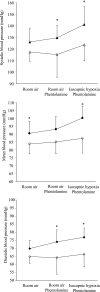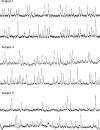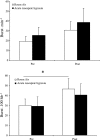Ventilatory, hemodynamic, sympathetic nervous system, and vascular reactivity changes after recurrent nocturnal sustained hypoxia in humans
- PMID: 18539753
- PMCID: PMC2519226
- DOI: 10.1152/ajpheart.00653.2007
Ventilatory, hemodynamic, sympathetic nervous system, and vascular reactivity changes after recurrent nocturnal sustained hypoxia in humans
Abstract
Recurrent and intermittent nocturnal hypoxia is characteristic of several diseases including chronic obstructive pulmonary disease, congestive heart failure, obesity-hypoventilation syndrome, and obstructive sleep apnea. The contribution of hypoxia to cardiovascular morbidity and mortality in these disease states is unclear, however. To investigate the impact of recurrent nocturnal hypoxia on hemodynamics, sympathetic activity, and vascular tone we evaluated 10 normal volunteers before and after 14 nights of nocturnal sustained hypoxia (mean oxygen saturation 84.2%, 9 h/night). Over the exposure, subjects exhibited ventilatory acclimatization to hypoxia as evidenced by an increase in resting ventilation (arterial Pco(2) 41.8 +/- 1.5 vs. 37.5 +/- 1.3 mmHg, mean +/- SD; P < 0.05) and in the isocapnic hypoxic ventilatory response (slope 0.49 +/- 0.1 vs. 1.32 +/- 0.2 l/min per 1% fall in saturation; P < 0.05). Subjects exhibited a significant increase in mean arterial pressure (86.7 +/- 6.1 vs. 90.5 +/- 7.6 mmHg; P < 0.001), muscle sympathetic nerve activity (20.8 +/- 2.8 vs. 28.2 +/- 3.3 bursts/min; P < 0.01), and forearm vascular resistance (39.6 +/- 3.5 vs. 47.5 +/- 4.8 mmHg.ml(-1).100 g tissue.min; P < 0.05). Forearm blood flow during acute isocapnic hypoxia was increased after exposure but during selective brachial intra-arterial vascular infusion of the alpha-blocker phentolamine it was unchanged after exposure. Finally, there was a decrease in reactive hyperemia to 15 min of forearm ischemia after the hypoxic exposure. Recurrent nocturnal hypoxia thus increases sympathetic activity and alters peripheral vascular tone. These changes may contribute to the increased cardiovascular and cerebrovascular risk associated with clinical diseases that are associated with chronic recurrent hypoxia.
Figures







References
-
- Arabi Y, Morgan BJ, Goodman B, Puleo DS, Xie A, Skatrud JB. Daytime blood pressure elevation after nocturnal hypoxia. J Appl Physiol 87: 689–698, 1999. - PubMed
-
- Bisgard GE Carotid body mechanisms in acclimatization to hypoxia. Respir Physiol 121: 237–246, 2000. - PubMed
-
- Chen J, He L, Dinger B, Stensaas L, Fidone S. Role of endothelin and endothelin A-type receptor in adaptation of the carotid body to chronic hypoxia. Am J Physiol Lung Cell Mol Physiol 282: L1314–L1323, 2002. - PubMed
-
- Cosentino F, Volpe M. Hypertension, stroke, endothelium. Curr Hypertens Rep 7: 68–71, 2005. - PubMed
Publication types
MeSH terms
Substances
Grants and funding
LinkOut - more resources
Full Text Sources
Medical

